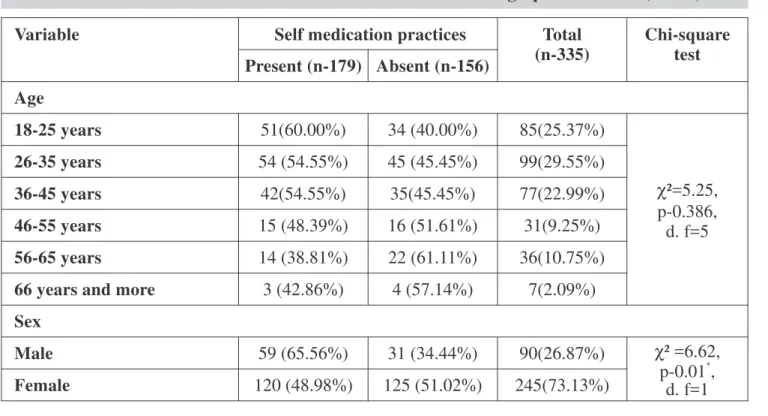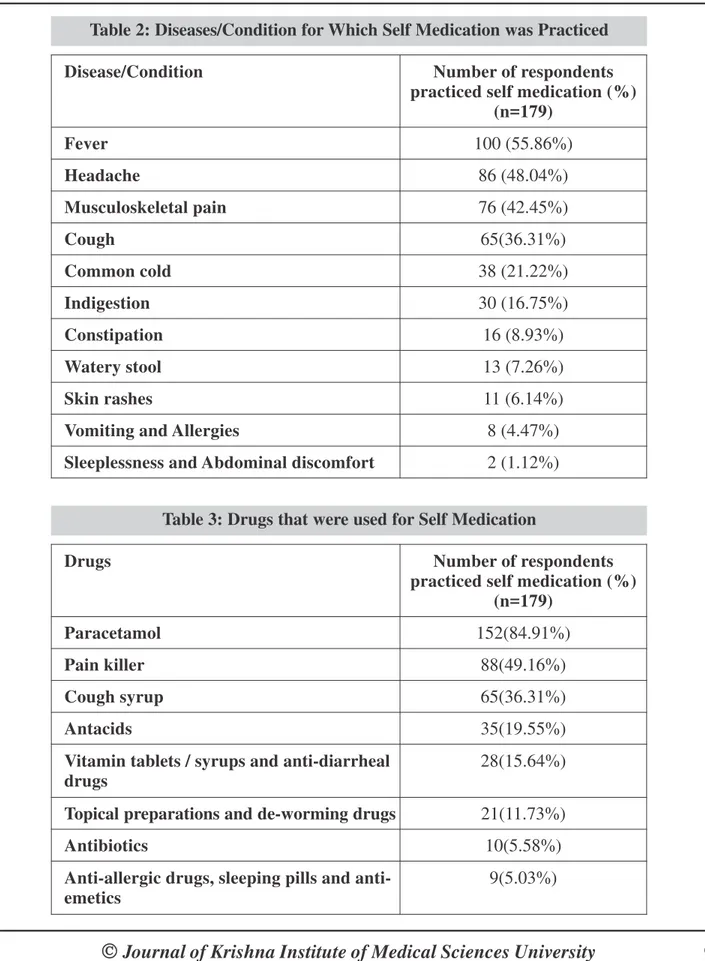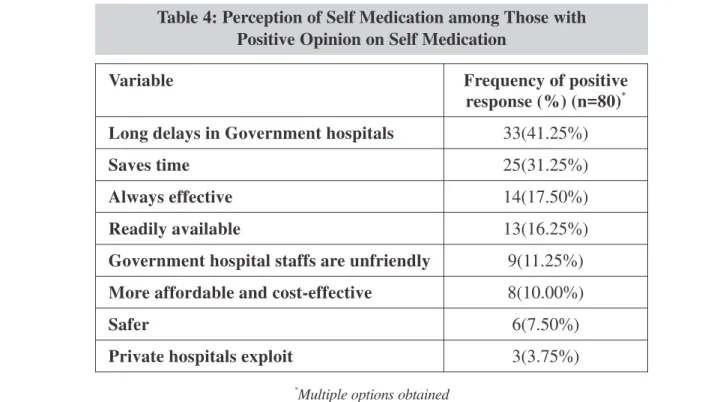ORI GI N AL ART I CLE
Self Medication: Predictors and Practices among Rural Population of Nellikuppam
Village, Kancheepuram District, Tamil Nadu
1* 1 1
Kalaivani Annadurai , Selvasri S , Jegadeesh Ramasamy 1
Department of Community Medicine, Shri Sathya Sai Medical College & Research Institute, Sri Balaji Vidyapeeth, Kancheepuram District - 603108 (Tamil Nadu), India
Abstract:
Background: Inappropriate self medication is one of the leading causes of growing antibiotic resistance in developing nations which poses a major public health threat worldwide and assessment of self medication practices is essential for better understanding of the problem. Aim and Objectives: To find out the predictors of self medication use among the residents of Nellikuppam village, Kancheepuram District, Tamil Nadu. To assess the self medication practices among the residents of Nellikuppam village, Kancheepuram District, Tamil Nadu. Material and Methods: This was a descriptive cross sectional study conducted among 335 adult households with six months recall period in Nellikuppam village of Tamil Nadu during May to October, 2014 using a pretested semi-structured questionnaire. Results: Prevalence of self medication among adult rural population was 53.43% and only half of the study population opined that it was harmful. Pharmacists (72.06%) were the major source of drug information on self medication. Paracetomol (84.91%) was the commonest drug used for self medication. Major predictors were perception of illness as minor ailment and unavailability of doctors in their locality. Nearly half of the current self medication users (47.49%) were in the idea of practicing self medication in the future. Conclusion: This study results implies the need for proper enforcement of legal measures towards the restriction of over the counter medicine and creating awareness among general population on adverse reaction of self medication.
Keywords: Self medication, antibiotics resistance, practices
Introduction:
Inappropriate self medication is one of the reasons for irrational drug use worldwide leading to overuse, underuse or misuse of medicines which results in wastage of scarce resources and widespread health hazards [9]. To the best of our knowledge there were no studies done so far in rural Tamil Nadu to find out the self medication practice. This study is therefore aimed at evaluating self-medication practice and its determinants among rural population of Tamil Nadu.
Material and Methods:
This was a descriptive cross sectional study conducted among households of Nellikuppam village, Kancheepuram District, Tamil Nadu during the period of June to July 2014. Details regarding houses were collected from village panchayat. There were 372 houses in Nellikuppam village during the study period. All the houses were selected (Universal sampling method), every house was visited and in each house, one participant preferably the head of the household or the spouse was selected and interviewed using pre-tested semi-structured questionnaire. After adjusting non-response of 10%, efforts were made to cover at least 335 houses. So, three hundred & thirty five were considered as sample size.
Pre-tested semi-structured questionnaire was used. It was translated to local language Tamil while interviewing the participants. Details of their socio demographic data was in Part I of the questionnaire, Part II consisted of questions assessing the predictors of self medication use and Part III consisted of questions assessing their self medication practices in the preceding six months. Institutional Ethics committee permission was obtained. Informed written consent was obtained from all the respondents in local language. After getting informed consent from the participant, the respondents were administered questionnaire through face to face interview method.
Statistical Analysis:
Data was entered in excel format and analyzed using SPSS 18 software. Descriptive statistics such as frequencies and percentages were used for analysis. Chi square test was used to check the test of significance between associated factors. P value of 0.05 was taken as statistically significant.
Results:
Among the study population of 335 rural adults, mean age was 36.43, ranged between 18 to 76 years, with standard deviation of 13.27 years. Nearly half of the respondents (54.92%) were below 35 years and 48.06% of them were homemaker, unemployed and students. Majority of them (73.13%) were females, of Hindu religion (92.84%) and married (83.28%) (Table1).
Prevalence of self medication among the study participants in the previous six months was found to be 53.43% and among those who practiced self medication (n-179), 99.44% used allopathy medication and 0.56% used homeopathy medicine. Gender, occupation and educational status of the respondents were significantly associated with self medication practices whereas age, religion and marital status were not associated with it (Table 1).
(63.13%) procured drugs by telling their symptoms to pharmacist, 35.20% purchased drugs over the counter by mentioning the name of the drugs and 1.67% procured drugs either by drug name or by pharmacists. Pharmacy (92.73%), other small shop (6.14%), neighbor (0.55%) and left over of previously prescribed medicines were the places for procuring medicines for self medication.
About 23.88% (n-80) of the study population opined that self medication can be given without consultation of doctors, and among them almost half of them 41.25% felt long delay in government hospitals as the main reason for seeking self medication (Table 4). Among those who were not favoring self medication (n-255), nearly three fourth 69.41% felt that it was harmful and 35.29% opined that medical expertise consultation was needed to treat any illnesses (Table 5).
Duration of the illness (60.89%), type of illness (51.64%), age of the patient (43.28%) followed by condition of the patient (8.65%) and gender of the patient (7.76%) were the major factors considered by the respondents as important things to sought immediate health care services over self medication.
Minor ailment (56.42%) and unavailability of doctors (22.34%) were the leading cause for practicing self medication. Previous experience of treating a similar ailment (18.43%) and ailment requiring rapid emergency care (11.17%) were the other reasons opted for practicing self medication. Nearly half of the current self medication users (47.49%) were in the idea of practicing self medication in the future. About 28.49% were not sure of their future self medication practices and 24.02% were determined not to practice self medication in the future.
Table 1: Self Medication Practices over Different Socio-Demographic Variables (n=335)
Variable Self medication practices Total (n-335)
Chi-square test Present (n-179) Absent (n-156)
Age
18-25 years 51(60.00%) 34 (40.00%) 85(25.37%)
c²=5.25, p-0.386,
d. f=5 26-35 years 54 (54.55%) 45 (45.45%) 99(29.55%)
36-45 years 42(54.55%) 35(45.45%) 77(22.99%)
46-55 years 15 (48.39%) 16 (51.61%) 31(9.25%)
56-65 years 14 (38.81%) 22 (61.11%) 36(10.75%)
66 years and more 3 (42.86%) 4 (57.14%) 7(2.09%)
Sex
Male 59 (65.56%) 31 (34.44%) 90(26.87%) c
*
p-0.01 , d. f=1 ² =6.62,
Religion
Hindus 169 (54.34%) 142 (45.66%) 311(92.84%)
c p-0.2, d. f=2 ²=3.13,
Muslims 7 (53.85%) 6 (46.15%) 13(3.88%)
Christians 3 (27.27%) 8 (72.73%) 11(3.28%)
Marital status
Single 33 (62.26%) 20 (37.74%) 53(15.82%)
c
p-0.30, d. f=2 ²=2.39, Married 145 (51.97%) 134 (48.03%) 279(83.28%)
Separated/widow 1 (33.33%) 2 (66.67%) 3(0.90%)
Occupation
Professional 35 (72.92%) 13 (27.08%) 48(14.33%)
c
*
p-<0.0001 , d. f=4 ²=23.64, Skilled 13 (72.22%) 5 (27.78%) 18(5.3%)
Semi-skilled 32 (61.54%) 20 (38.46%) 52(15.52%)
Unskilled 17 (30.36%) 39 (69.64%) 56(16.72%)
Housewife/Unemployed/ Student
82 (50.93%) 79 (49.07%) 161(48.06%)
Educational status
Illiterate 46 (56.79%) 35 (43.21%) 81(24.18%)
c
*
p-0.02 , d. f=5 ²=13.4, Primary schooling 28 (41.79%) 39 (58.21%) 67 (20.00%)
Secondary schooling 37 (49.33%) 38 (50.67%) 75 (22.39%)
Higher secondary schooling 22 (64.71%) 12 (35.29%) 34 (10.15%)
Intermediate/Diploma 7 (35.00%) 13 (65.00%) 20(5.97%)
Graduate/Postgraduate/ Professional
39 (67.24%) 19 (32.76%) 58(17.31%)
*
Table 2: Diseases/Condition for Which Self Medication was Practiced
Disease/Condition Number of respondents practiced self medication (%)
(n=179)
Fever 100 (55.86%)
Headache 86 (48.04%)
Musculoskeletal pain 76 (42.45%)
Cough 65(36.31%)
Common cold 38 (21.22%)
Indigestion 30 (16.75%)
Constipation 16 (8.93%)
Watery stool 13 (7.26%)
Skin rashes 11 (6.14%)
Vomiting and Allergies 8 (4.47%)
Sleeplessness and Abdominal discomfort 2 (1.12%)
Drugs Number of respondents
practiced self medication (%) (n=179)
Paracetamol 152(84.91%)
Pain killer 88(49.16%)
Cough syrup 65(36.31%)
Antacids 35(19.55%)
Vitamin tablets / syrups and anti-diarrheal drugs
28(15.64%)
Topical preparations and de-worming drugs 21(11.73%)
Antibiotics 10(5.58%)
Anti-allergic drugs, sleeping pills and anti-emetics
Variable Frequency of positive
*
response (%) (n=80)
Long delays in Government hospitals 33(41.25%)
Saves time 25(31.25%)
Always effective 14(17.50%)
Readily available 13(16.25%)
Government hospital staffs are unfriendly 9(11.25%)
More affordable and cost-effective 8(10.00%)
Safer 6(7.50%)
Private hospitals exploit 3(3.75%) Table 4: Perception of Self Medication among Those with
Positive Opinion on Self Medication
*
Multiple options obtained
Variable Frequency of positive
*
response (%) (n=255)
Unsafe 177(69.41%)
It requires medical expertise 90(35.29%)
Associated with side-effects 61(23.92%)
Seldom effective 19(7.45%)
Expensive 3(1.17%)
Table 5: Perceptions of Self Medication among Those with Negative Views towards Self Medication
*
Discussion:
Our study found that the prevalence of self medication was 53.43%, but wide range of prevalence was observed within India (11.9% to 81.5%) from various studies reported from Pudhucherry, Mumbai, Hyderabad, Bhopal and rural Maharashtra [8, 10-13]. On the other hand, international studies reported prevalence of 10.5% to 48% which was documented from various studies from Srilanka, Mexico, Spain, Saudi Arabia, Germany, Jordan and Malaysia. This wide difference in prevalence could be due to different socio-demographic population, cultural practices, seasonal variation of illnesses, health seeking behaviour of the people and considered recall period [16-18, 20-22, 24].
In this study about 52.84% of the study population was of the opinion that self medication was harmful, our study finding was quite satisfactory when compared to Pudhucherry study, where 33.4% of the study population felt that it was unsafe [13]. In the present study, gender was significantly associated with self medication practice, similar findings were reported from Pudhucherry study, Saudi Arabia and Spanish study [13, 16, 20]. But our finding was contrary to the report from North East India and Mexican study where they reported no gender difference among self medication users [15, 21].
Educational status of the respondents were associated significantly with self medication practice, this finding was similar to the findings from Spanish study, Mexican study and Germany [20, 21, 24]. But, contrary to the report from North East India where it documented no difference in the educational status and self medication practice [15]. Age was not significantly associated but this finding was contrary to the reports from Pudhucherry study, Saudi Arabia study, Spanish
study, Germany and Jordan where they documented significant difference between age of the participants and self medication practice [13,16,20,22,24].
This study finding revealed that fever (55.86%), headache (48.04%), and musculoskeletal pain (42.45%) were the common symptoms for which they procured drugs without doctor's consultation and this finding was consistent with the previous study findings from Mumbai, Hyderabad, Pudhucherry, Pune, Utter Pradesh and Ethiopia [4,6,7,10,11,14]. Butthis was contradictory to what has been reported from Portugal where they documented 'other alimentary tract and metabolism products' (75%), 74.4% of throat preparation followed by 70% of anti-emetics as the common symptoms for self medication practice, whereas study from Germany reported different findings, it found that the main drugs being for respiratory tract symptoms (32.1%) followed by alimentary tract symptoms (21.6%) [23-24]. Paracetomol (84.91%) was the commonest drug used for self medication in our study and this confirms the finding from Bhopal [12]. However study from Utter Pradesh reported that non steroidal anti-inflammatory drugs and antihistamines were the popular drugs used for self medication [14].
Pharmacists (72.06%) were the key source of information about self medication drugs in the present study. Similar findings were observed in Pudhucherry and Mumbai [7,10]. In Pune study, previous doctor's prescription and in Hyderabad study, doctors were the major source of information for drugs used for self medication [4,11].
Pharmacies (92.73%) were the important place for procuring medicines for self medication and similar finding was observed in Saudi Arabian study [16]. In our study, majority of them (63.13%) procured drugs by telling their symptoms to pharmacist. This finding was similar to the finding from Mumbai [10]. However, in Pudhucherry and Ethiopian study only one fourth of the self medication users mentioned their symptoms to pharmacist to procure drugs [13,19]. In our study, 99.44% of those self medication users used allopathy medication but study from rural Maharashtra and Hyderabad,three fourth of them preferred allopathic medicine [8, 11]. Nearly half of the current self medication users (47.49%)
were in the idea of practicing self medication in the future in our study, but Pudhucherry study, reported that 92.86% of the study population were in the favor of self medication practice in the future[13].
To conclude, the prevalence of self medication among adult rural population of Nellikuppam, Tamil Nadu was 53.43% and only half of the study population opined that it was harmful. Area of greater concern, are the major predictors of self medication such as perception of illness as minor ailment and unavailability of doctors, since former leads to mismanagement of disease, even fatal for the self medication users, and later show the lack of adequate health care services in this rural area. Since pharmacists were playing key role in self medication practice, future studies should be carried out to assess the role of pharmacist in self medication.
Acknowledgement:
We were extremely thankful for ICMR for their encouragement and support.
References
1. World Health Organization. Guidelines for the regulatory assessment of medicinal products for use in self-medication. Geneva; 2000. Available from http://apps.who.int/medicinedocs/en/d/Js2218e/.
nd
Accessed on 2 January 2014.
2. Self-care in the context of Primary Health Care. New Delhi: WHO Regional Office for South-East Asia, 2009. Available from http://203.90.70.117/
th
PDS_DOCS/B4301.pdf. Accessed 4 January 2014. 3. Sharma R, Verma U, Sharma CL, Kapoor B. Self
medication among urban population of Jammu City.
Ind J Pharmacol 2005; 37(1): 37–45.
4. Keche Y, Yegnanarayan R, Bhoyar S, Agarwal R, Chavan R and Mahendrakar P. Self medication pattern in rural areas in Pune, India. Int J Med Public Health 2012; 2(4):7-11.
5. Kaushal J, Gupta MC, Jindal P, and Verma S. Self-Medication Patterns and Drug Use Behavior in Housewives Belonging to the Middle Income Group in a City in Northern India. Indian J Community Med 2012; 37(1):16-19.
6. Worku S, Abebe G, Mariam. Practice of Self-medication in Jimma Town. Ethiop J Health Dev 2003; 17(2):111–6.
7. Balmurugan E, Ganesh K. Prevalence of self medication use in coastal regions of South India. BJMP 2011; 4(3):a428.
8. Phalke VD, Phalke DB, Durgawale PM. Self medication practice in rural Maharashtra. Indian J
*
Author for Correspondence: Dr. Kalaivani, Department of Community Medicine, Shri Sathya Sai Medical College & Research Institute, Sri Balaji Vidyapeeth Kancheepuram district, Tamil Nadu, India- 603108
Email: kalaimedicos11@gmail.com Cell: 9500029829 9. World health organization. The Pursuit of Responsible
Use of Medicines: Sharing and Learning from Country Experiences. 2012. Available from http://www.who.int/ th medicines/areas/rational_use/en/. Accessed on 9 January 2014.
10. Gupta P, Bobhate P, Shrivastav S. Determinants of self medication practices in an urban slum community.
Asian J Pharm Clin Res 2011; 4(3):54-7.
11. Kulkarni PK, Khan M, Chandrasekhar A. Self medication practices among urban slum dwellers in south Indian city. Int J Pharm Bio Sci 2012; 3(3):81-7. 12. Reetesh M, Papiya B, Sonam J. A study of self
medication among the people of Bhopal region, Madhya Pradesh, India. Inter Res J Pharm 2011; 2(12):163-5.
13. Selvaraj K, Kumar SG, Ramalingam A. Prevalence of self-medication practices and its associated factors in Urban Puducherry, India. Perspect Clin Res 2014; 5(1):32-6.
14. Ahmad A, Patel I, Mohanta GP, Balkrishnan R. Evaluation of self medication practices in rural area of town Sahaswan at Northern India. Ann Med Health Sci Res 2014; 4(Suppl 2):S73-8.
15. Chakraborty K, Chakraborty A, Devi D and Devi J. Family self medication in children attending a tertiary care hospital in Northeast India. Int J Pharm Sci Res 2012; 3(12): 4899-902.
16. Alghanim SA. Self-medication practice among patients in a public health care system. East Mediterr
Health J 2011; 17(5):409-16.
17. Wijesinghea PR, Jayakodyb RL, de A Seneviratnec R. Prevalence and predictors of self medication in a selected urban and rural district of Sri Lanka. WHO
South-East Asia J Public Health 2012; 1(1):28-41.
18. Mathialagan A, Kaur S. Community perception on the use of Over the Counter (OTC) medications in Malaysia. IJSER 2012; 3(8):1-4.
19. Eticha T, Mesfin K. Self-Medication Practices in Mekelle, Ethiopia. PLoS One 2014; 9(5): e97464. 20. Carrasco-Garrido P, Jiménez-García R, Barrera VH,
Gil de Miguel A. Predictive factors of self-medicated drug use among the Spanish adult population.
Pharmacoepidemiol Drug Saf 2008; 17(2): 193-9.
21. Pagan JA, Ross S, Yau J, Polsky D. Self-medication and health insurance coverage in Mexico. Health
Policy 2006; 75(2): 170–7.
22. Yousef AM, Al-Bakri AG, Bustanji Y, Wazaify M. Self-medication patterns in Amman, Jordan. Pharm World Sci 2008; 30(1):24-30.
23. Nunes de Melo M, Madureira B, Nunes Ferreira AP, Mendes Z, Miranda Ada C, Martins AP. Prevalence of self-medication in rural areas of Portugal. Pharm
World Sci 2006; 28(1):19-25.
24. Du Y, Knopf H. Self-medication among children and adolescents in Germany: results of the National Health Survey for Children and Adolescents (KiGGS). Br J


